

Ancient Egypt: Crash Course World History #4. Ancient Egypt - Gods, Pyramids, Mummies, Pharaohs, Queens, Hieroglyphics, History, Life in Ancient Egypt, Maps. Welcome to Living in Ancient Egypt. More Breeds Added!
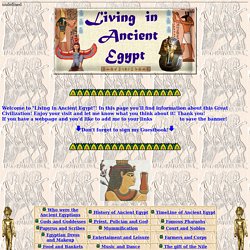
If you have any comments or ideas? Important Facts about Cleopatra. This is part of a series (study guide) on the legendary Egyptian queen Cleopatra.
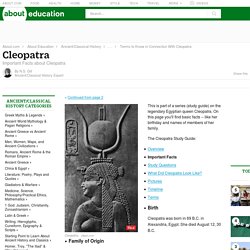
On this page you'll find basic facts -- like her birthday and names of members of her family. The Cleopatra Study Guide: Overview | Important Facts | Study Questions | What Did Cleopatra Look Like? | Pictures | Timeline | Terms. Egypt Cult of the Sun God and Akhenaten's Monotheism. Ancient Egyptian Warfare for Kids! Ancient Egyptian Warfare - what kinds of weapons and armor did the Ancient Egyptians use?

What wars did they fight? The Nile's Impact on Ancient Egypt. Although most historians and geographers find it difficult to agree on many aspects of the Nile, including its length and source, virtually everyone acknowledges that Ancient Egypt could never have existed without the great body of water.

Egypt, known to many as the home of the Great Pyramids, the Great Sphinx and other marvels of the ancient world, isn't ideally located for advanced civilization. Other than the Nile, Egypt is surrounded by tons of sand, which isn't exactly conducive to agriculture and other cornerstones of civilization. Fortunately for the Egyptians, they knew just how to finesse the Nile and its capabilities to turn what would appear to be a barren wasteland into a thriving empire. Giza 3D. Pyramid of Snefru at Maidum.
Builder of several pyramids, Pharaoh Snefru, secured access to monument-building stone via military victories outside Egypt.

Likely influenced by the Step Pyramid of Djoser, Snefru, the first king of the 4th dynasty (time line), began a seven-level stepped pyramid some 35 miles (56 kilometers) south of Saqqara. By the time his workers had reached the fourth or fifth level, Snefru upped the ante to eight steps. The first Egyptian pyramid with an aboveground burial chamber (just above the first step level), the Maidum tomb may represent an effort to raise the chamber closer to the sun god.
Another innovation is the archlike design of the burial chamber's walls. The pyramid was temporarily abandoned 15 years into Snefru's reign—probably when he moved his court north from Memphis to Dahshur. Mummies - Death and the Afterlife in Ancient Egypt. The British Museum of London, England, has the largest and most comprehensive collection of ancient Egyptian material outside of Cairo.
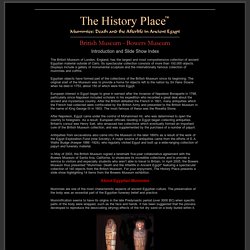
Its spectacular collection consists of more than 100,000 objects. Displays include a gallery of monumental sculpture and the internationally famous collection of mummies and coffins. Egyptian objects have formed part of the collections of the British Museum since its beginning. NOVA Online/Pyramids/Ancient Egypt. History: Egyptians. Ancient Egypt. History - Ancient History in depth: Akhenaten and the Amarna Period. Queen Cleopatra VII - Last Pharaoh of Egypt. "For (as they say) it was not because her [Cleopatra's] beauty in itself was so striking that it stunned the onlooker, but the inescapable impression produced by daily contact with her: the attractiveness in the persuasiveness of her talk, and the character that surrounded her conversation was stimulating.
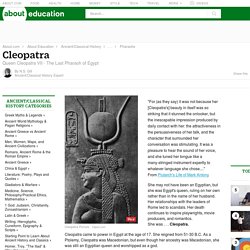
It was a pleasure to hear the sound of her voice, and she tuned her tongue like a many-stringed instrument expertly to whatever language she chose.... " From Plutarch's Life of Mark Antony She may not have been an Egyptian, but she was Egypt's queen, ruling on her own rather than in the name of her husband.
Her relationships with the leaders of Rome led to scandals. Her death continues to inspire playwrights, movie producers, and romantics. Egypt - History - From Ancient Times to the Modern Period. Egypt, a concise history See Also: Books About Egypt Map of Modern Egypt Ami Isseroff Ramses II ruled from 1279 to 1212 BC and is known for his prodigious building projects, which raised temples, statues and other monuments throughout Egypt.
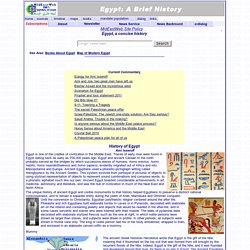
History - Ancient History in depth: Ancient Egypt and the Modern World. National Geographic. Writer Carl Hoffman traveled to Egypt in February 2011, a week after popular demonstrations led to the president's resignation.
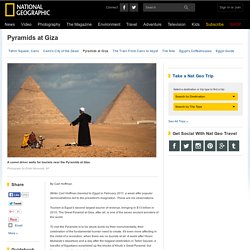
These are his observations. Tourism is Egypt’s second largest source of revenue, bringing in $13 billion in 2010. The Great Pyramid at Giza, after all, is one of the seven ancient wonders of the world. To visit the Pyramids is to be struck dumb by their monumentality, their celebration of the fundamental human need to create. It's even more affecting in the midst of a revolution, when there are no tourists at all. I have visited them before, but this time they felt different. In the empty quiet I had a chance to talk to the horsemen and camel drivers who usually hustle rides to tourists. Ancient Egyptian Gods. Museum of Science : Ancient Egypt Science & Technology. Ancient Egyptians as Experts in Geometry. What's Sacred About Geometry?

The Egyptians desired to create harmony in everything around them. The balance and symmetry of their ancient structures–from the pyramids and temples, to statues and obelisks–are testimonies to the Egyptian’s standard for harmony. This standard is translated into Sacred Geometry, the geometry employed in their sacred architecture. The primary principle behind this is the relationship between progression and proportion. This series of progression and proportion, occurring naturally in the universe (e.g. in the number of layers in a chambered nautilus or petals of a flower) is evident in Egypt’s buildings and design. Aside from this sacred series, there is also the “sacred ratio” or the “golden ratio” applied extensively to hieroglyphs, pyramids and other monuments. Egypt's ancient royalty used serious weapons - Technology & science - Science - LiveScience.
Elite members of ancient Egypt, including the pharaoh himself, likely wielded ornate daggers, swords and axes in battle, or to personally execute prisoners, rather than using the shiny metal for ceremonial purposes, research suggests. The weapons were used during the Bronze Age, a period between 5,000 and 3,000 years ago when the civilization was at its height, according to Daniel Boatright, an Egyptologist at Isle of Wight College in the United Kingdom. This finding is "strange considering the amount of literature that's been composed so far that basically says that all of them were for ritualistic purposes and were never used in battle," Boatright told LiveScience. Royalty are known to have gone into battle.
The Stargazers of Ancient Egypt. Introduction to Ancient Egypt. Egypt: Science, Math, and Technology. Ancient Egypt Timeline and Lesson Plans: Timeline of the Old Kingdom, the Middle Kingdom, and the New Kingdom. Written by: Noreen Gunnell • edited by: SForsyth • updated: 2/15/2013 Learn about some of the major events that happened in Ancient Egypt that over the Old, Middle, and New Kingdoms plus everything in between. Learn significant dates, events, and people. Vocabulary terms are in bold italics. This article is meant to be used as a reference with lesson plans in this series on Ancient Egypt. It is a basic timeline that lists significant dates, events, and people.TimelineOld Kingdom: (3200-2180 BC)Menes unites Upper & Lower Egypt & sets up First Dynasty.